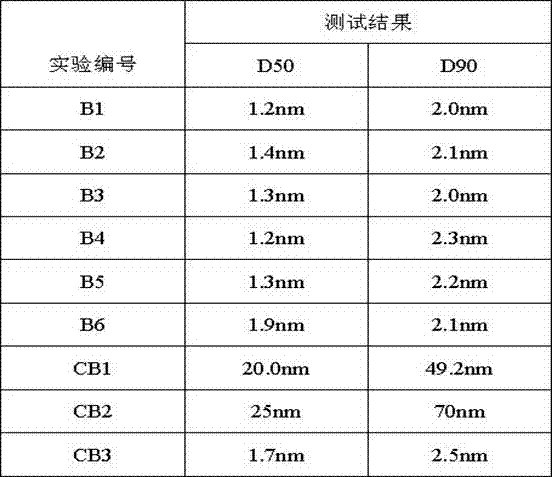A kind of preparation method of copper conductive ink
A technology of conductive ink and copper salt, which is applied in ink, household utensils, applications, etc., can solve the problems of unstable copper particles and wide particle size distribution of copper particles, and achieve no chemical toxicity, concentrated particle size distribution, and cheap and easy-to-obtain raw materials Effect
- Summary
- Abstract
- Description
- Claims
- Application Information
AI Technical Summary
Problems solved by technology
Method used
Image
Examples
preparation example Construction
[0013] The present invention provides a method for preparing copper conductive ink. The method includes the following steps:
[0014] S1. The copper salt aqueous solution is heated to 78-82°C, and then the ascorbic acid aqueous solution and the phytic acid aqueous solution are added dropwise at the same time, and the temperature is maintained at 78-82°C until the reaction is completed to obtain a copper nanoparticle dispersion;
[0015] S2, centrifugal separation of the copper nanoparticle dispersion liquid, washing and drying, to obtain copper particles;
[0016] S3, mixing copper nanoparticles with a solvent to obtain a copper conductive ink.
[0017] In the preparation method of the copper conductive ink of the present invention, ascorbic acid is used as a reducing agent and modifier at the same time. Ascorbic acid firstly provides an active hydrogen to reduce the divalent copper ion to zero-valent copper to generate water and semi-dehydrogenated ascorbic acid. Semi-dehydroascorbic...
Embodiment 1
[0032] 10mmol CuCl 2 ·2H 2 Dissolve O in 50ml deionized water, stir the solution with magnetic force, and heat it to 80℃ with an oil bath; 2 ·2H 2 Evenly drop 50ml, 0.1mol / L ascorbic acid aqueous solution and 5ml, 0.05mol / L phytic acid aqueous solution into the O solution for a dripping time of 40min to 60min, and control the dripping speed of both. After the reaction is completed, the temperature is maintained for 30 minutes, and the mixture is naturally cooled to obtain a copper nanoparticle dispersion A1 with high dispersion stability.
Embodiment 2
[0034] The copper nanoparticle dispersion A2 was prepared according to the method of Example 1. The difference is: the copper salt is copper nitrate, the concentration is 0.05 mol / L, and the volume is 200 ml; the concentration of the ascorbic acid aqueous solution is 0.025 mol / L, the volume is 40 ml, and the inositol The concentration of hexaphosphoric acid aqueous solution is 0.0125mol / L.
PUM
| Property | Measurement | Unit |
|---|---|---|
| particle size | aaaaa | aaaaa |
Abstract
Description
Claims
Application Information
 Login to View More
Login to View More - R&D Engineer
- R&D Manager
- IP Professional
- Industry Leading Data Capabilities
- Powerful AI technology
- Patent DNA Extraction
Browse by: Latest US Patents, China's latest patents, Technical Efficacy Thesaurus, Application Domain, Technology Topic, Popular Technical Reports.
© 2024 PatSnap. All rights reserved.Legal|Privacy policy|Modern Slavery Act Transparency Statement|Sitemap|About US| Contact US: help@patsnap.com









